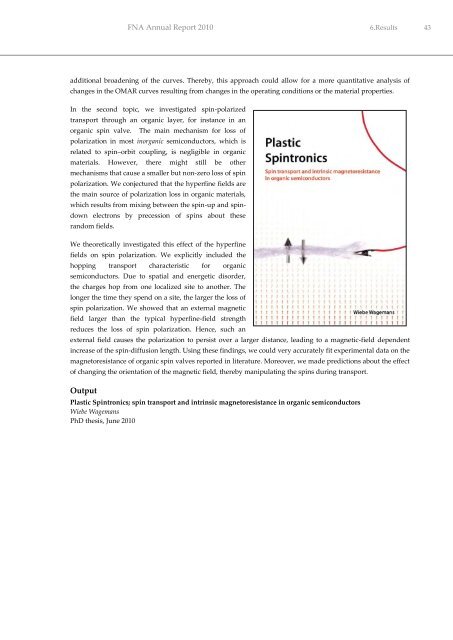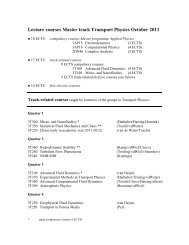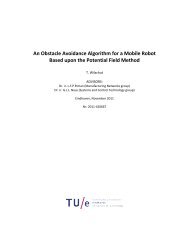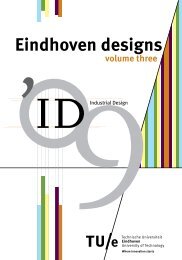FNA Annual Report 2010 - Technische Universiteit Eindhoven
FNA Annual Report 2010 - Technische Universiteit Eindhoven
FNA Annual Report 2010 - Technische Universiteit Eindhoven
Create successful ePaper yourself
Turn your PDF publications into a flip-book with our unique Google optimized e-Paper software.
<strong>FNA</strong> <strong>Annual</strong> <strong>Report</strong> <strong>2010</strong> 6.Results 43<br />
additional broadening of the curves. Thereby, this approach could allow for a more quantitative analysis of<br />
changes in the OMAR curves resulting from changes in the operating conditions or the material properties.<br />
In the second topic, we investigated spin-polarized<br />
transport through an organic layer, for instance in an<br />
organic spin valve.<br />
The main mechanism for loss of<br />
polarization in most inorganic semiconductors, which is<br />
related to spin–orbit coupling, is negligible in organic<br />
materials. However, there might still be other<br />
mechanisms that cause a smaller but non-zero loss of spin<br />
polarization. We conjectured that the hyperfine fields are<br />
the main source of polarization loss in organic materials,<br />
which results from mixing between the spin-up and spindown<br />
electrons by precession of spins about these<br />
random fields.<br />
We theoretically investigated this effect of the hyperfine<br />
fields on spin polarization. We explicitly included the<br />
hopping transport characteristic for organic<br />
semiconductors. Due to spatial and energetic disorder,<br />
the charges hop from one localized site to another. The<br />
longer the time they spend on a site, the larger the loss of<br />
spin polarization. We showed that an external magnetic<br />
field larger than the typical hyperfine-field strength<br />
reduces the loss of spin polarization. Hence, such an<br />
external field causes the polarization to persist over a larger distance, leading to a magnetic-field dependent<br />
increase of the spin-diffusion length. Using these findings, we could very accurately fit experimental data on the<br />
magnetoresistance of organic spin valves reported in literature. Moreover, we made predictions about the effect<br />
of changing the orientation of the magnetic field, thereby manipulating the spins during transport.<br />
Output<br />
Plastic Spintronics; spin transport and intrinsic magnetoresistance in organic semiconductors<br />
Wiebe Wagemans<br />
PhD thesis, June <strong>2010</strong>

















